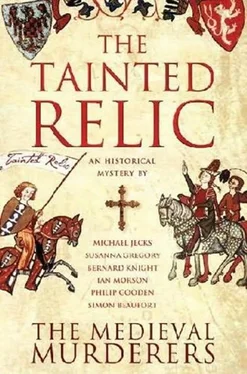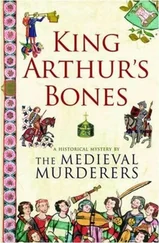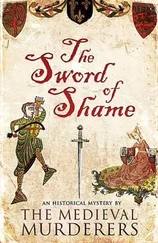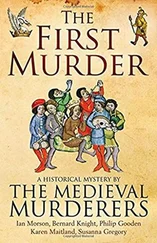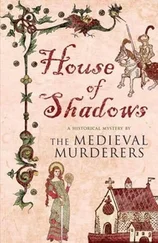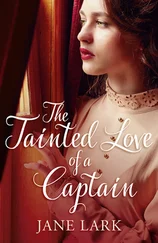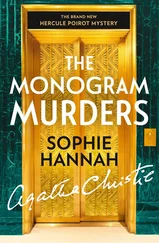‘It is worth a fortune,’ replied Tomas. ‘And London is the place where fortunes are made.’
Seton gazed at him in alarm. ‘You mean he will sell it? But it might fall into the hands of someone unscrupulous!’
Tomas nonchalantly drew a knife from his belt and hugged Seton to him as he slipped the blade into his companion’s stomach. Seton’s eyes bulged, and he struggled for a moment before going limp. The friar shoved him off the cart and watched the body bounce into a ditch.
‘You will never know what happens to it,’ he murmured. ‘And neither will your Minister-General.’
Historical Note
Blood relics were controversial items throughout the Middle Ages, and they gave rise to a complex scholastic debate. This concerned not only whether such relics could exist and, if so, whether they should be venerated, but also touched upon such topics as the definitions of death and resurrection, transubstantiation and the mass, and the precise nature of the kind of blood that may or may not have been involved. Since contemporary medical science was of the belief that there were several kinds of blood in the human body, the specific type alleged to have been contained in blood relics, such as the ones at Hailes or Ashridge, was extremely contentious, and had all manner of theological implications.
There were two peaks in the polemic. One occurred in the 1350s, when the Franciscan Francis Bajulus of Barcelona declared that the blood of Christ’s Passion had become separated from His divinity; he based his claim on the writings of the Provençal Franciscan Francis de Meyronnes (died c.1325). The claim might not sound particularly significant today, but in the 1350s it created an uproar. The implication was that if blood and body had indeed become separated, then the blood was unworthy of veneration-which raised questions about the veneration of Christ’s blood in the mass. This in turn had profound implications for fundamental tenets of Christian orthodoxy. Bajulus’s theory was referred to the nearest Dominican inquisitor, and it is no surprise to learn that it was deemed heresy. Thus began yet another chapter in the long series of disagreements between White and Black friars.
The second peak in the debate came a century later, with the Franciscans vociferously arguing that Holy Blood relics were sacred, and the Dominicans furiously seeking to suppress the claims. The battle lines between the two Orders over these issues remained in place until well into the seventeenth century.
Norwich Cathedral was one of several English foundations said to possess a portion of Holy Blood. It came from Fécamp in the 1170s, and may have been an attempt to attract pilgrims who might otherwise have gone to the shrine of Thomas á Becket in Canterbury. It was still there in 1247, and may explain why it was the Bishop of Norwich who was invited to give the sermon when Henry III gave his portion of Holy Blood to Westminster in that year. Norwich Cathedral was ravaged by fire in 1272 and, despite attempts to save it, the crystal vase in which the blood was kept cracked and the reliquary was damaged by flames. The blood was removed from the split vessel, and the monks were amazed by the ‘miraculous’ suspension of most of the blood in the upper part of the vase (it had probably dried).
Adherence to one or other side of the argument can be seen in the world of Renaissance art: the slab on which the dead Jesus lay was either painted red, showing an affinity with the Franciscans’ beliefs, or grey, indicating a preference for the Dominicans’. Presumably, a multi-coloured one indicates a hedging of bets.
London, 16??
Although the interior of the tent was dim, making it difficult to see clearly, there could be no doubt about it. The man was dead. Ulysses Hatch, publisher and dealer in books, was lying flat on his back. His arms and legs were splayed out and his eyes stared sightlessly at the faded stripes of the tent fabric overhead. He was a large man and the hummock of his belly almost reached to our knees. There wasn’t much doubt either that he’d died by violence. A great splotch spread out like a bloody flag across the incline between his triple chins and his chest.
The dead man and his lumber took up so much space there wasn’t much room for the three of us who were still alive and upright. All around was the clutter of his trade, piles of books, bundles of pamphlets. There were in addition a couple of trunks, stuffed with bolts of cloth, with parcel-gilt plates and goblets and other things, for Ulysses Hatch had not restricted himself to bookselling. I knew this because barely an hour earlier I’d been gazing at the interior of the smaller trunk while Master Hatch carefully withdrew from it a little box that was swaddled in coarse woollen cloth and jumbled, apparently carelessly, among other items. When he told me what the box contained, my vision swam and my legs almost gave way. Moments later, the wooden box was once again tucked among the jumble inside the trunk, which was in turn padlocked by its owner. Now the lid of this same trunk lay open while Ulysses Hatch was spreadeagled on the ground near by. I hadn’t checked yet but I would have bet half a year’s pay that the little box had gone.
The interior of the tent was generously proportioned but a heavy brown curtain almost divided it in two, cutting off the area by the entrance where the book vendor had set out his table and making a private chamber behind. At that moment I was very thankful for that thick fustian curtain. Beyond it, the sounds of the fair proceeded as though nothing had happened. Against the background hum of the crowd, we could hear the cries of ballad singers and confectioners and horse coursers. Within the tent the only sounds were the buzzing of a pair of flies and the slow-drawn breath of three baffled and frightened stage players. The smells that I’d been aware of on my first visit to the tent-the smell of summer’s end and of musty fabric and unwanted paper-were now overlaid by a bitter, burnt odour.
Not one of us had bargained on this development. And it had seemed such a straightforward errand. I was only doing a favour for a man whom I was proud to consider my friend, and the others were here to keep me company. Early that morning we’d been in good spirits. And now look at us, standing over the corpse of a fat publisher and wondering what to do next…
They say that Saint Bartholomew’s Fair is the biggest in the whole world, and who am I to contradict them? Certainly it sometimes seems as though the whole world flocks to the fair for a few days in August, all for the pleasure of being crammed into a couple of acres of land in Smithfield.
It was a hot morning at the back end of summer. Behind us the London walls were visible above a jumble of rooftops while before us the fair was bubbling away like a cooking pot. The hazy air was filled with the cries of the traders and ballad-mongers and the smell of roasting flesh. Smithfield is the place where animals are sold for slaughter, and it’s hard to avoid the idea that the same fate awaits plenty of the Bartholomew visitors. Not slaughter maybe but a good fleecing. At least, that’s what might occur to your average Londoner as he surveys the simple country folk picking their way across the green fields of Hoxton and Islington.
I don’t know whether this thought was in the minds of my two companions as we watched the crowds flowing towards the encampment of stands and booths, each flying their banners and signs like an army before battle. Maybe my friends were preoccupied with less cynical notions: a sort of London pride that we lived in a place that was great enough to bring the world to its door. And a sort of London pity for those unfortunate enough to have to dwell somewhere else.
Читать дальше
